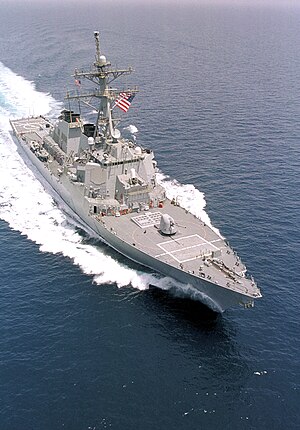USS Curtis Wilbur

USS Curtis Wilbur transiting the Persian Gulf in 1999
|
|
| History | |
|---|---|
|
|
|
| Name: | USS Curtis Wilbur |
| Namesake: | Curtis D. Wilbur |
| Ordered: | 13 December 1988 |
| Builder: | Bath Iron Works |
| Laid down: | 12 March 1991 |
| Launched: | 16 May 1992 |
| Commissioned: | 19 March 1994 |
| Homeport: | Yokosuka, Japan |
| Identification: | DDG-54 |
| Motto: |
|
| Nickname(s): | Steel Hammer of the Republic |
| Status: | in active service |
| Badge: |  |
| General characteristics | |
| Class and type: | Arleigh Burke-class destroyer |
| Displacement: |
|
| Length: | 505 ft (154 m) |
| Beam: | 66 ft (20 m) |
| Draft: | 31 ft (9.4 m) |
| Propulsion: | 4 General Electric LM2500-30 gas turbines, two shafts, 100,000 total shaft horsepower (75 MW) |
| Speed: | >30 knots (56 km/h) |
| Range: |
|
| Complement: | |
| Sensors and processing systems: |
|
| Electronic warfare & decoys: |
|
| Armament: |
|
| Aircraft carried: | 2 Sikorsky MH-60R helicopters can be embarked |
USS Curtis Wilbur (DDG-54) is the fourth Arleigh Burke-class guided missile destroyer. Curtis Wilbur was named for Curtis D. Wilbur, forty-third Secretary of the Navy, who served under President Calvin Coolidge. In 2016 she was based at Yokosuka, Japan, as part of Destroyer Squadron 15.
Built by Bath Iron Works in Bath, Maine, she was commissioned in Long Beach, California, on 19 March 1994. The keynote speaker for the ceremony was then-Secretary of the Navy, John H. Dalton.
During the summer of 1994, Curtis Wilbur participated in RIMPAC '94, a major multi-national exercise involving more than thirty ships as well as numerous submarines and air assets, both carrier- and land-based. During this exercise, she performed duties as Force Air Defense Coordinator. Also that summer, the Board of Inspection and Survey conducted Final Contract Trials to assess the material status of the ship. Curtis Wilbur became the first ship of the class, and only the second ship ever to complete the examination with zero mission degrading deficiencies.
In October 1994, Curtis Wilbur became the first Aegis-equipped ship to integrate women into the crew.
Curtis Wilbur departed on her first Western Pacific Deployment on 31 July 1995, transiting the Pacific and heading to the Persian Gulf. While deployed with the United States Naval Forces Central Command, she supported Operations Southern Watch and Vigilant Sentinel. During her 100 days in theater, she served as Air Warfare Commander, Surface Warfare Commander, Undersea Warfare Commander, and Strike Warfare Commander. Curtis Wilbur also served as a member of the United States Fifth Fleet Expeditionary Task Force supporting United Nations sanctions against Iraq.
...
Wikipedia
